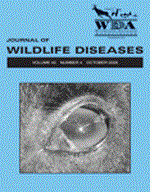We examined the impact of season and habitat on Sin Nombre virus (SNV) seroprevalence in deer mice (Peromyscus maniculatus) in Utah's Great Basin Desert from May 2002 through summer 2003. Low mouse captures in 2002 limited analysis for that year. In two seasons during 2003, mouse density and sagebrush cover were positively linked (spring: r=0.8, P=0.01; summer: r=0.8, P=0.04). In the spring, seroprevalence was negatively correlated with density (r=−0.9, P<0.01); male and female antibody prevalence did not differ; and scarring was unrelated to antibody status. In the summer, density and antibody prevalence were unrelated; male seroprevalence was higher (χ2=3.6, P=0.05); and seropositive mice had more scars (t=2.5, P=0.02). We speculate nesting behavior could maintain SNV over the winter, whereas summer territoriality could be responsible for transmission.
How to translate text using browser tools
1 October 2006
Changes in Sin Nombre Virus Antibody Prevalence in Deer Mice Across Seasons: The Interaction Between Habitat, Sex, and Infection in Deer Mice
Jessica M. C. Pearce-Duvet,
Stephen C. St. Jeor,
John D. Boone,
M. Denise Dearing

Journal of Wildlife Diseases
Vol. 42 • No. 4
October 2006
Vol. 42 • No. 4
October 2006
deer mouse
frequency-dependent transmission
habitat quality
Peromyscus maniculatus
Seasonality
Sin Nombre virus




